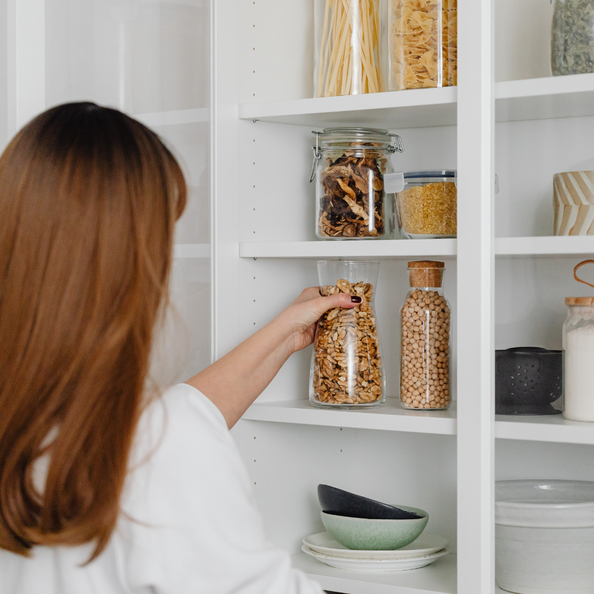A well-organized pantry makes meal preparation quicker and easier.


You'll save time looking for ingredients, money on wasted food and energy cleaning up after a meal that went bad because of missing ingredients. Here are some tips to help organize your own kitchen cabinet:
The first step to keeping your pantry organized is to make sure you have a place for everything. Make sure you have containers that are easy to open and close, as well as labels on them so that you can easily see what's inside.Another tip is to keep the rest of your kitchen clean because if it's messy in there, chances are high that food will get lost in the shuffle.
Next designate a pantry storage space. The goal is to make this area as convenient and accessible as possible, so it should be close to the kitchen and have easy access from all sides. You also want to make sure that it's well lit and clean, so you can easily see what you're looking for when it's time to pull out ingredients or cook something new. Make sure you have enough space for everything--it's easy to get carried away when organizing your pantry because there are so many options for storing items that don't fit in cabinets or drawers (like large bags of flour or sugar). But remember: if there isn't room somewhere else in your house where something could go instead (such as under beds), then consider leaving things where they were before.
Now onto picking your storage containers. Choose containers that are easy to clean and can be sealed. Get ones with lids if possible, but if not then make sure they have some sort of sealant on them so that no pests can get in. You also want airtight seals so they don't lose freshness over time--this is especially important when storing grains or flour! Make sure they're the right size for the food you're storing; don't use tiny jars just because they're cute (unless it's jam). You'll end up wasting space and money on extra packaging materials like plastic wrap or foil if everything doesn't fit properly inside your container anyway--so choose wisely.
Next up - let's begin labeling. Labeling your canned goods, cereals and other dry foods can be a great way to keep track of what you have on hand.
Use a label maker that is easy to use. For example, some models allow you to print labels from your smartphone or tablet through Wi-Fi connectivity. Make sure the labels are clear so they can be easily read even if they get dusty or dirty over time (e.g., "brown sugar"). You may also want to consider using coloured markers in order for them not only stand out but also differentiate themselves from each other (e.g., red marker for tomato sauce vs blue marker for spaghetti sauce). This will help prevent mix-ups when looking through pantry shelves in search of specific ingredients needed for cooking.
Once your labeling is complete, it's time to begin filling out your pantry. We highly recommend keeping things organized and storing them dependant on the ingredients. For example, when you're organizing your baking ingredients, it's important to keep them in a separate area from other foods. Baking ingredients are very sensitive to heat and moisture, so they should be stored in airtight containers that are kept in a cool, dry place. If possible, store them in their original containers so you know what everything is when you need it!If your pantry isn't big enough for an entire section dedicated to baking supplies (and let's face it: most aren't), consider storing them on one of the shelves near where they'll be used most often--in this case: next to your mixing bowls and measuring cups.
In addition to keeping your pantry organized, it's important for you to make sure that you have some area dedicated to dry goods like pasta, cereal and cookies. These are the items that tend to take up the most space in a standard kitchen cupboard or pantry and often get lost among other items.When storing these types of foods at home, keep them in an easily accessible place so that they can be quickly retrieved when needed (and not forgotten!). Also make sure there is enough room between each product so they don't get damaged by moisture or dust build-up over time.
Now that you know how to organize your pantry, it's time to start putting these tips into practice. The first step is to designate a space for your pantry and then decide what kind of storage containers will work best for you. Next comes labeling! Make sure that every item in your pantry has its own label so it's easy to find when you need it. Finally, fill up those shelves with everything from pasta dishes and baked goods to cereals and cookies - whatever items will make meal prep easier for yourself (and others).
